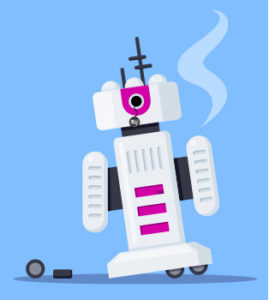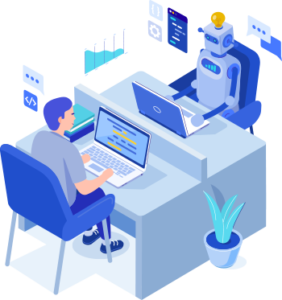Learn How to Avoid The Traps of RPA
The idea of RPA has been around for almost a decade now. The original hype was “Why outsource when you can automate?”
But outsource what? That’s the problem.
RPA as a replacement for outsourcing work doesn’t attack root business problems. Left alone, inefficient workflows, legacy applications, and lack of enterprise-level automation create risk of failure.
For RPA to be transformative it must be applied correctly, and with the right mindset. There are three dangers that threaten RPA digital transformation potential:
Automating Bad Processes
RPA is the silver bullet for bad business processes.
OK, maybe that’s a little harsh, but if data must be moved from one application to another through manual processes (performed by robots or people…) shouldn’t we focus on attacking the root of the problem?
 Bad processes (that’s the way we’ve always done it), prevent the growth of new opportunities by limiting business transformation. If headcount for people performing bad processes is reduced, all the organization enjoys is some saved revenue.
Bad processes (that’s the way we’ve always done it), prevent the growth of new opportunities by limiting business transformation. If headcount for people performing bad processes is reduced, all the organization enjoys is some saved revenue.
While that may be valuable, I don’t think it’s enough to help create the necessary new value propositions required for true transformation.
Adding to the bad processes is the fact that most RPA implementations are not for unattended processes.
Instead, most are attended solutions that require some amount of human-in-the-loop. So, reducing headcount can’t really be counted on anyway.
Use RPA as a catalyst for change. Think beyond just automating manual processes. What new business outcomes will you achieve? How will transforming archaic workflows generate new business outcomes?
Robotic Process Automation Extends the Life of Legacy Platforms
RPA is a great band-aid for supporting legacy applications. But why do we keep them around?
Easy. They aren’t all that painful to support. Or are they?
Any COBOL programmers out there who can save our unemployment systems? I don’t think most people would disagree that it’s time to modernize them, yet… they often remain.
Interesting fact: 10 important U.S. government agencies are running on systems as old as 51 years with hardware as old as 18.
Because it’s harder to peer into the private industry, here are some interesting(?) statistics on the age of U.S. government agency core software:
- Department of Defense – 14 years old
- Department of Education – 46 years old
- Department of Health and Human Services – 50 years old
- Department of Homeland Security – 8 years old
- Department of the Interior – 18 years old
- Department of the Treasury – 51 years old
- Department of Transportation – 35 years old
- Office of Personnel Management – 35 years old
- Small Business Administration – 17 years old
- Social Security Administration – 45 years old
And would you be surprised to discover that they all report elevated risk involved with these legacy systems?
Some like the Department of Homeland Security even report a high risk (rather than just “moderately high.” But never fear, at least two departments have plans for what the private sector would recognize as “passable.”
This isn’t a rant on government modernization, but just calling out the fact that legacy systems are a core part of how business is transacted today.
And while RPA does solve some of these systems’ core obstacles, it really isn’t a step forward (not to mention that RPA is also known to break these legacy apps…).
RPA Isn't Enterprise-Wide Automated Data Integration
Robotic Process Automation was supposed to be a toolkit for low-code integration between data applications. But has that really worked out to be the case?
Successful RPA implementations require seeing through the hype. If you re-work your understanding of “Process” in Robotic Process Automation as Robotic Task Automation instead, you’re on right track for success with RPA.
 And this is why we’re all seeing the trend of RPA companies acquiring and partnering with other intelligence-based technologies. It’s the right move.
And this is why we’re all seeing the trend of RPA companies acquiring and partnering with other intelligence-based technologies. It’s the right move.- As the first entrant to the world of RPA, Blue Prism is certainly paving the way.
- Their Digital Exchange is an intelligent automation “app store” combined with a thriving online community.
But it’s not just RPA tools making the acquisitions:
- SAP is looking to further business opportunities with its machine learning tool Leonardo by acquiring RPA software Contextor.
- Automation Anywhere acquired Klevops, UiPath acquired ProcessGold and StepShot – the list goes on and on.
The bottom line is clear – we must position RPA within an ecosystem of tools, technologies, and upgraded business processes to achieve integrated automation.
What the marketplace really needs is a re-imagining of work automation. And it’s not all about the technology.
Innovation and progress hinge on People + Process + Technology. When too much focus is on any one of these three, results suffer.
Today’s technology leaders must embrace the reality – integrated automation is the new norm.
Processes must be changed, new technology and toolkits must be adopted, and deep ecosystems of people and skills must be developed to solve the challenging problems.